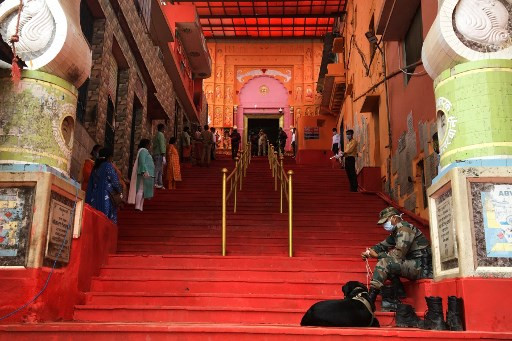Popular Reads
Top Results
Can't find what you're looking for?
View all search resultsPopular Reads
Top Results
Can't find what you're looking for?
View all search resultsAyodhya, India's flashpoint holy site
Change text size
Gift Premium Articles
to Anyone
 A member of a bomb squad team sits on the step of a staircase at the Hanuman Garhi temple before the arrival of India's Prime Minister to offer a prayer ahead of the groundbreaking ceremony of the Ram Temple in Ayodhya on August 5, 2020. India's Prime Minister Narendra Modi will lay the foundation stone for a grand Hindu temple in a highly anticipated ceremony on August 5 at a holy site that was bitterly contested by Muslims, officials said. The Supreme Court ruled in November 2019 that a temple could be built in Ayodhya, where Hindu zealots demolished a 460-year-old mosque in 1992.
(AFP/Sanjay Kanojia )
A member of a bomb squad team sits on the step of a staircase at the Hanuman Garhi temple before the arrival of India's Prime Minister to offer a prayer ahead of the groundbreaking ceremony of the Ram Temple in Ayodhya on August 5, 2020. India's Prime Minister Narendra Modi will lay the foundation stone for a grand Hindu temple in a highly anticipated ceremony on August 5 at a holy site that was bitterly contested by Muslims, officials said. The Supreme Court ruled in November 2019 that a temple could be built in Ayodhya, where Hindu zealots demolished a 460-year-old mosque in 1992.
(AFP/Sanjay Kanojia )
I
ndian Prime Minister Narendra Modi will help lay the foundations on Wednesday for a "grand" new Hindu temple at a flashpoint holy site that has been the spark for some of India's worst sectarian violence.
AFP looks at the history of the three-acre patch of land in the holy northern town of Ayodhya and why it has long been an explosive source of contention between India's majority Hindus and minority Muslims.
Why is it disputed?
Hindus and Muslims have for decades been bitterly divided over the 16th-century Babri mosque in Ayodhya. Hindus believe the mosque was built on the ruins of an ancient temple dedicated to their god Ram, who is also believed to have been born on or near the site. Tensions boiled over in 1992 when a Hindu mob tore the mosque to the ground, sparking religious violence that left about 2,000 dead across India.
How long has it been a flashpoint?
Hindus believe a Muslim conqueror razed the Ram temple in the 1500s to make way for the mosque. The British erected a fence in the 19th century to separate places of worship so that Muslims could worship in the inner court and Hindus the outer. But in 1949, idols of Lord Ram appeared inside the mosque, allegedly placed by Hindus.
Who was behind its destruction?
In 1984, a group of Hindus formed a committee to "liberate" the birthplace of Ram and build a temple at the disputed site. The movement was headed by L K Advani, a senior figure in the ruling BJP, now headed by Modi. Its supporters began travelling to the site to demand a temple be built.
When did tensions escalate?
On December 6, 1992 a huge Hindu crowd converged on the mosque site to symbolically and provocatively lay the first stone of the new temple. The 200,000-strong mob broke through police cordons, first smashing three domes to rubble before reducing the rest of the historic mosque to ruins. The destruction triggered some of the worst religious riots since India's bloody partition in 1947. Ten years later a trainload of Hindu activists were burned alive as they returned from Ayodhya, sparking retaliatory riots in Gujarat state that left upwards of 1,000 people dead, again most of them Muslims.
Where does it stand legally?
In November India's highest court finally settled a decades-long, arcane legal fight that even saw the infant Ram represented by a lawyer. The ruling awarded the site to Hindus, in a major victory for Modi and the BJP. The Muslim side were given a nearby location to construct a "prominent" new mosque.
What will the temple look like?
To shouts of "Hail Lord Ram", Modi said in parliament in February that the new temple would be "grand". His right-hand man, Home Minister Amit Shah, said it would "touch the sky". Wednesday's ceremony, held at a time recommended by astrologers and involving 135 "revered saints", will use soil from almost 2,000 holy sites around India and water of about 100 holy rivers. Silver bricks will be used in the foundations.









